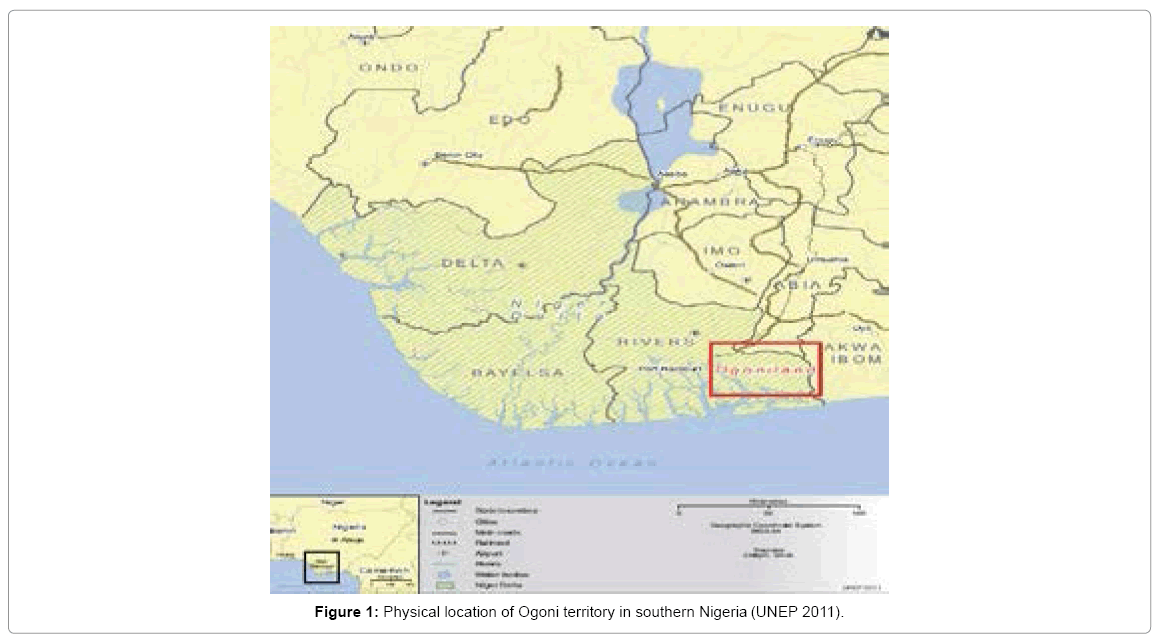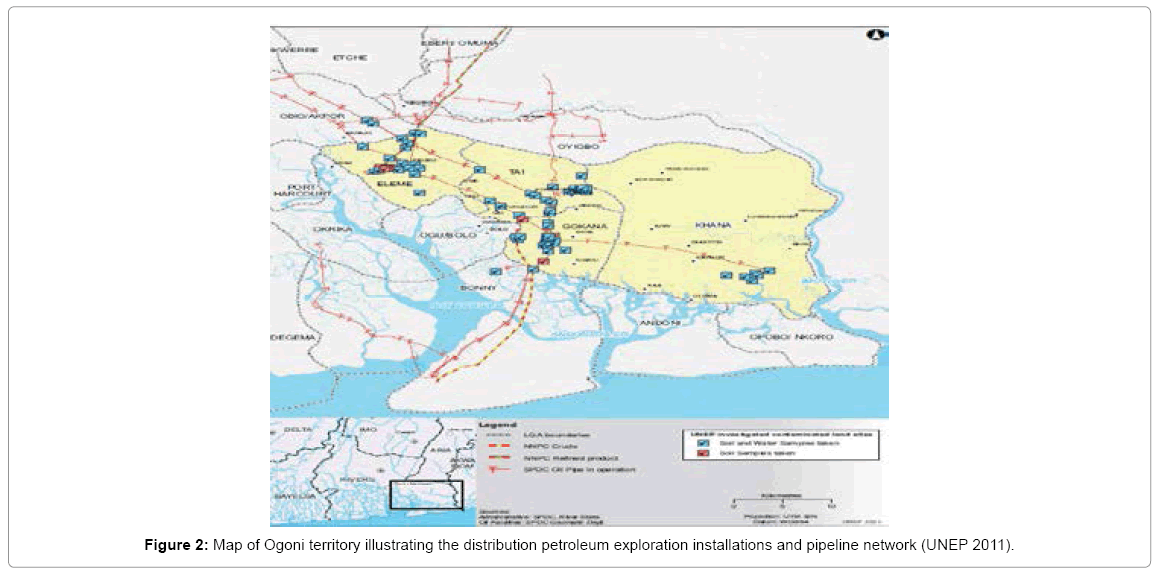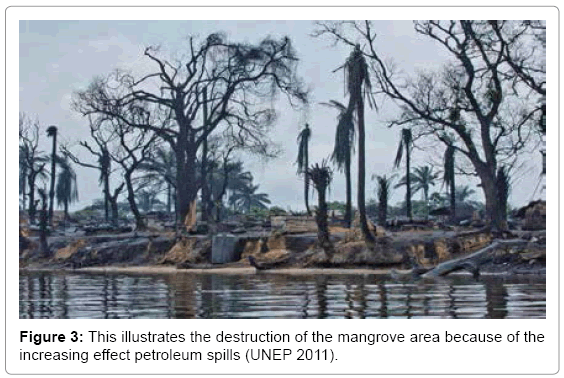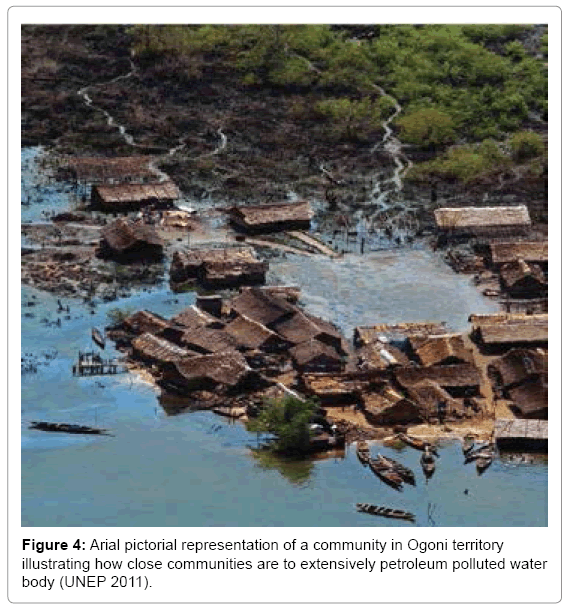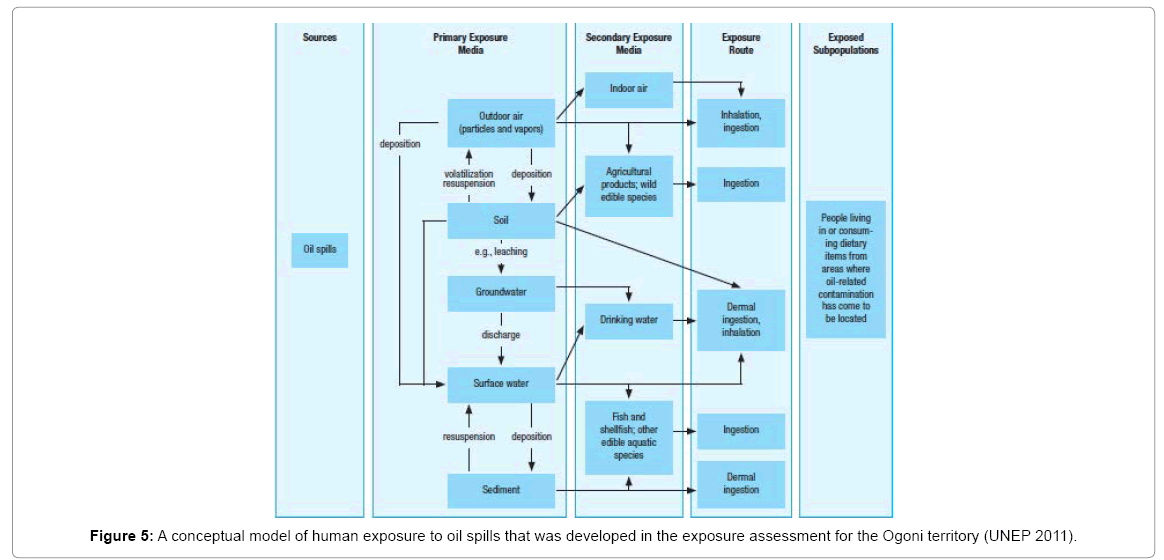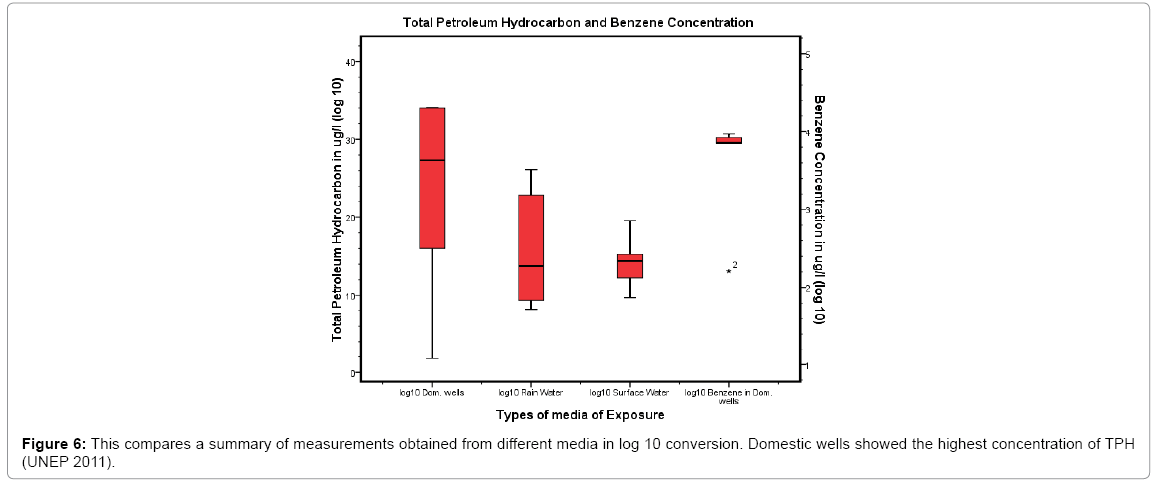Hematologic Hazards and Community Petroleum Exploration Exposures in Ogoni Territory Nigeria
Received: 23-Mar-2018 / Accepted Date: 30-Mar-2018 / Published Date: 07-Apr-2018 DOI: 10.4172/2573-458X.1000152
Abstract
Leukemia remains one of the most misunderstood malignancies despite remarkable advances in molecular biology and immunology. Progress made in understanding its etiology and pathophysiology has been limited by its low incidence rate and the potential for multiple etiological factors. Some of the described etiological factors include environmental factors (benzene, ionizing radiation, non-ionizing electromagnetic fields, pesticides, occupational or parental occupational exposures), diet factors (vitamins A and D), infection factors (retroviruses), medical and iatrogenic factors (diagnostic radiographs, radiation therapy, and chemotherapy agents) and hereditary and genetic factors.
Keywords: Leukemia; Environmental factors; Iatrogenic factors; Crude oil exploration
Introduction
Leukemia remains one of the most misunderstood malignancies despite remarkable advances in molecular biology and immunology. Progress made in understanding its etiology and pathophysiology has been limited by its low incidence rate and the potential for multiple etiological factors. Some of the described etiological factors include environmental factors (benzene, ionizing radiation, non-ionizing electromagnetic fields, pesticides, occupational or parental occupational exposures), diet factors (vitamins A and D), infection factors (retroviruses), medical and iatrogenic factors (diagnostic radiographs, radiation therapy, and chemotherapy agents) and hereditary and genetic factors. Of these factors, environmental agents have been particularly emphasized. Perhaps because these environmental agents could be identified and subsequently modified. The benzene component of petroleum is a known leukocyte carcinogen. Many occupational human risk assessment studies have validated this in benzene exposures in petroleum distillation facilities, but ecological risk assessments are not as common. Among crude oil exploration countries today, Nigeria is ranked highly, with a petroleum industry that is the largest in Africa. According to the US Energy Information Administration (2014), “Nigeria has an estimated oil reserve of between 16-22 billion barrels distributed between 359 oil fields and thousands of oil well facilities all over the Niger Delta region of southern part of Nigeria” [1]. Networks of rusty surface laid pipelines passing through several communities, link this structure to storage deports, refinery facilities, and ports. In addition, there are significant natural gas flares within these locations. These constitute extensive sources in the environment which expose humans to potentially dangerous chemicals like benzene. The situation is worsened by prevalent illicit bunkering and refinery activities which occur within residential areas. As a result, lakes of crude oil are common within the communities. Exploration activities are also occasional sources of crude oil spillage which are equally poorly managed. It is estimated that over “1.5 million tons of oil has been released within the Niger delta region” since commercial exploration commenced in 1960 [2]. Despite this situation there is no uniform framework for addressing these dire environmental and human emergencies. Ogoni territory, an area of about 1,000 km2, located in Rivers State on the coast of the Gulf of Guinea, east of the city of Port Harcourt (Figures 1-3), is an example of a typical community in Nigeria that has virtually lost their identity because of petroleum spillage. Their primary source of living is agriculture and their source water source are mainly streams and domestic wells, most of which are contaminated with different mixtures of petroleum components [3]. Oil exploration activities coordinated by the federal government in this territory include: 116 drilled Wells, 89 completed Wells, 12 Oilfields (Figure 3) and numerous flow stations with an average capacity of 185,000 barrels per day. Apart from directly affecting the prosperity and lives of the people, there are potentially direct health effects that may not be as conspicuous. Of all the components of petroleum, benzene has been most consistently associated with hematologic effects based on evidence from both humans and laboratory animals. The International Agency for research on Cancer has classified benzene as carcinogenic to humans (Group 1) [4,5]. Chronic exposure to benzene is associated with Acute Myelogenous Leukemia and Myelodysplastic syndromes [6]. Although there is a limited understanding of the pathophysiology of leukemia, there have been a number of postulations that attempt to explain how benzene is able to induce leukemic clone development and proliferation [7]. It is commonly thought that benzene is able to induce leukemic clone development and proliferation through the following steps: a) activation of benzene in the liver to phenolic metabolites; b) transport of these metabolites to the bone marrow and conversion to semiquinone radicals and quinones via peroxidase enzymes; c) generation of active oxygen species via redox cycling; d) damage to tubulin, histone proteins, topoisomerase II, other DNA associated proteins, and DNA itself including DNA strand breakage, mitotic recombination, chromosome translocations and aneuploidy [7]. In another postulation, Mc Hale et al. [8] in his work suggests that “benzene induced oxidative stress, several receptor dysregulations and a reduced immunosurveillance” may result in clonal expansion of stem cells and subsequent production of leukemic stem. Whichever the path that may be involved what is established is that benzene exposure increases in many folds one’s chances of acquiring hematologic cancers. Based on these well documented toxicity reports, the World Health Organization recommends a maximum “drinking water benzene concentration of 0.01 mg/L and places the excess life time risk of leukemia for exposure to airborne benzene concentration of 10-4 at 17” [5]. Some indigenous environmental activist in the past presented reports that indicated that surface water samples taken from some locations in the Ogoni territory had very high concentrations of benzene, more than the WHO guidelines [9]. However, this was not taken seriously, perhaps because of conflict of interest and lack of reliability. Most of their campaigns also met with resistance from the notorious past military regimes.
The United Nations environmental assessment is the first independent and systematic environmental assessment of the territory which took place in 2011. Five years and counting the situation remains the same. In addition to known carcinogenic potential, benzene is a well-documented cause of aplastic anemia [10]. It is also noted to be a cause of reduction in B cell and T cell proliferation which are both cells required for immunity [11]. Examined rabbits exposed to different levels of crude oil in their diets and observed a significant dose response decrease in erythrocyte, platelets, lymphocytes, and monocytes values [12]. In situations of spills in the environment, petroleum breaks down into unpredictable mixtures of structures which are dispersed into the soil, water, and air forming complicated exposure to health hazards in surrounding communities [13]. This work is meant to highlight the findings of the UN project and the risk for leukemia which this portends for the Ogoni community. The environmental assessment of Ogoni territory covered land, groundwater, surface water, sediment, vegetation, air pollution, and industry practices. It also captured a 122 km pipeline (and its immediate surroundings), all oil spill sites, oil wells, and other oil-related facilities in Ogoni territory, including decommissioned and abandoned facilities. In this assessment, samples were collected in a non-random method (primary based on convenience and accessibility) because of the security challenges in the area. Information was gathered and analysed in a weight-of-evidence approach and geographic information system mapping outputs were utilized. Samples were taken from well water, creek sediment, surface water, rainwater, fish, and air from areas predicted by GIS generated maps. The samples were collected following internationally accepted sample management procedures and dispatched for analysis to ISO 17025 accredited laboratories in Europe because of lack of wellequipped laboratories. Altogether about 4,000 samples were analysed. On the average 3 samples were collected from each site.
Discussion
From the data presented, there is a wide range of measurements of total petroleum hydrocarbon and benzene from the different exposure media or sites analyzed. The highest concentration of total petroleum hydrocarbon was found from measurements from sediments from the creeks (about 20000 mg/kg). High total petroleum hydrocarbons are known stresses to the mangrove swamp habitat [14]. Membrane narcosis has been suggested as the mechanism for the mangrove vegetation destruction. Other effects of high TPH in swampy environment include reduced cohesiveness, compaction of the soil, and threat to biodiversity [15]. Pictorial presentation in the UNEP report showed extensive mangrove degradation. Swamp habitat damages have the potential to affect fishery activities; increasing flooding in the area and leading to progressive coastal damage (Figures 3 and 4). This of course does not directly affect the human hematological system, but indirectly through distortion of the ecosystem chain its effects get back to humans. There is also established possibilities of human exposure to petroleum hydrocarbons through sea food contamination. Components of petroleum in sediments could also leach and run off into surface water or get evaporated and transmitted with the wind current. The most significant result comes from measurement of total petroleum hydrocarbon and benzene that was observed in domestic well, which serves as a primary source of water for most people in the territory. Benzene concentration in domestic well waters were found to be over 9,000 times higher than the WHO concentration associated with 10% risk of blood cancer in some locations [5] (Figures 5-7). A number of studies on the carcinogenicity of dermal application of crude oil to animals and human were reviewed [4] and therefore was concluded that there was limited evidence of carcinogenicity. On the other hand, the same review established that exposure to benzene in water or air is associated with many hematologic carcinogenic events. Benzene was detected in air in all the areas monitored in Ogoni at concentrations ranging from 0.155 to 48.2 μg/m3. About 10% of these measurements in Ogoni territory were higher than the concentrations which the WHO and the United States Environmental Protection Agency (USEPA) report as 1 in 10,000 cancer risk.
Occupational exposure to benzene has been widely studied. Most of the studies were able to associate benzene exposure to different types of leukemia. Khalade et al. [16] conducted a systematic review of 15 works and based on his metanalysis he was able to establish that exposure to benzene at work is associated with increased occurrence of chronic lymphocytic leukemia. In a similar study done by there was statistically significant evidence of an association of benzene exposure with non-Hodgkin Lymphomas. Although these are important insights on the toxicity of benzene, community exposures are not exactly the same with occupational exposures, which typically occur in enclosures. However, some studies also established significant association of benzene with hematological malignancies in community settings. In a case control study conducted by De Roos et al. [17], there was 90% increase risk for non-Hodgkin’s Lymphoma associated with community proximity to petroleum refineries. A similar study conducted on Residential Exposure to Petrochemicals and the Risk of Leukemia utilizing Geographic Information System Tools to estimate individuallevel residential exposure, Yu et al. [18] was able to establish a positive association between leukemia and residents aged 20-29 years. When compared with this study, there is no difference between the settings of these studies and most communities in Ogoni territory. When compared, direct exposure to benzene by people in Ogoni territory, as presented in the result, is much higher.
Legislations and Regulations
The ultimate aim of environmental laws and policies is to achieve a sustainable environment. The focus is on the human ecosystem consisting of the natural environment and humans that interact with it. Policies form the foundation on which guidelines for protecting basic natural resources, such as air, land and water are based on. In spite of its effectiveness, a number of issues usually arise and are very common in developing nations like Nigeria. Firstly, available laws are very inadequate to meet the contemporary challenges. Some are foundation laws that came with the inception of agencies in the country. Several studies that examined Nigerian environmental laws indicate that this law no longer met prevailing problems and proposes an urgent requirement to phase them out [19-24]. Secondly, very few programs come out from environmental health policies. In Nigeria many of the environmental laws were usually drafted by military governments with no plans of translating them into interventions that protect the environment and the people [21]. The aim had been to explore natural resources with out of touch drafts/policies to back activities. This has been the case with respect to petroleum exploration in Nigeria. Unfortunately, most of these attitudes has not changed with the coming of democracy in 1999. In addition to these realities, application of the few laws that exist is also profoundly challenged by corruption and inefficiency [22,25-27]. Apart from the fact that many of the laws are not well adapted to prevailing challenges, the communities were not involved during the planning of the policy. There is a need to educate the people adequately and enjoin their collaborations to improve outcome. In addition there is an urgent need to develop and monitor environmental and health data to guide interventions. There is presently, a lack of environmental health data that ought to form the basis for which hypothesis are tested and policies are developed [19,28-34]. There are rarely detailed assessment and evaluation programs to ensure continuous improvement of laws and programs as well.
Conclusion
The United Nation Ogoni territory environmental assessment is an important step because it brought to the world’s attention the first independently and systematically conducted environmental assessment of oil exploration communities in Nigeria. It brought with it calls to raise more conscientious political discussions about the dilapidated state of environmental health in Nigeria. However, even with a damning report, there has not been adequate response. The public health response and exposure management in Ogoni Territory is still at the planning stages of stakeholder identification. A quick examination of legislative frame work of environmental protection reveals a very out of touch sector. Many of the laws have never been evaluated or improved to meet the contemporary changes. In many instances as well, laws have been poorly applied. There has also been an abject failure to meet the need for emergent relief where petroleum pollution threatens the health of people and the environment, nor has there been long term plan for sustainability which requires significant community participation.
There is adequate evidence to forecast extensive occurrence of leukemia in communities like Ogoni in Nigeria. This implies that even when the legislative, emergent and long term solutions are addressed, emphasis should also be placed on environmental and health surveillance for communities historically affected by petroleum pollutions.
References
- Osuji LC, Onojake CM (2004) Trace heavy metals associated with crude oil: A case study of ebochaâ€8 oilâ€spillâ€polluted site in Niger delta, Nigeria. Chem Biodivers 1: 1708-1715.
- Kadafa AA (2012) Oil exploration and spillage in the Niger Delta of Nigeria. Civil Environ Res 2: 38-51.
- Ana GR, Sridhar MKC, Bamgboye EA (2009) Environmental risk factors and health outcomes in selected communities of the Niger delta area, Nigeria. Perspect Public Health 129: 183-191.
- World Health Organization (2010) Exposure to benzene: A major public health concern.
- David G, Sherilyn GA, Dennis P (2010) Benzene and human health: A historical review and appraisal of associations with various diseases critical reviews in toxicology. Crit Rev Toxicol 40: 1-46.
- Smith MT (1996) The mechanism of benzene-induced leukemia: A hypothesis and speculations on the causes of leukemia. Environ Health Perspect 104: 1219-1225.
- Mc Hale CM, Zhang L, Smith MT (2012) Current understanding of the mechanism of benzene-induced leukemia in humans: Implications for risk assessment. Carcinogenesis 33: 240-252.
- Linden O, Palsson J (2013) Oil contamination in Ogoni land, Niger delta. Ambio 42: 685-701.
- Sudakov KV (1992) Stress postulate: Analysis from the position of general theory of functional systems. Pathophysiologic Exp Ther 4: 86-93.
- Ovuru SS, Ekweozor IKE (2005) Hematological changes associated with crude oil ingestion in experimental rabbits. Afr J Biotechnol 3: 346-348.
- Pollard SJT, Whittaker M, Risden GC (1999) The faith of heavy oil wastes in soil microcosms I: A performance assessment of biotransformation indices. Sci Total Environ 226: 1-22
- Diop ES (1993) Conservation and sustainable utilization of mangrove forest in Latin America and African regions. Mangrove Ecosyst Techn Rep.
- (2007) The environmental implications of the UCM in sediments of the New York harbour complex. A final report to the Hudson River foundation.
- Khalade A, Jaakkola MS, Pukkala E, Aakkola JJ (2010). Research exposure to benzene at work and the risk of leukemia: A systematic review and meta-analysis. Environ Health 9: 1-8.
- De Roos AJ, Davis S, Colt JS, Blair A, Airola M, et al. (2010) Residential proximity to industrial facilities and risk of non-Hodgkin lymphoma. Environ Res 110: 70-78.
- Yu CL, Wang SF, Wu MT, Pan BJ, Ho CK, et al. (2005) Residential exposure to petrochemicals and risk of leukemia: Using GIS tools to estimate individual residential exposure levels. Cancer Res 65: 517.
- Ijaiya H, Joseph OT (2014) Rethinking environmental law enforcement in Nigeria. Beijing Law Revie 5: 306.
- Eneh OC, Agbazue VC (2011) Protection of Nigeria's environment: A critical policy review. J Env Sci Tech 4: 490-497.
- Nwafor JC (2006) Environmental impact assessment for sustainable development: The Nigerian perspective. Environment and Development Policy Centre for Africa (EDPCA).
- Anukam LC (1997) Case study IV-Nigeria. In: Helmer R, Hespanhol I (eds.) Water pollution control: A guide to the use of water quality management principles. Taylor and Francis, Washington DC: WHO/UNEP, pp: 322-345.
- Chen Z, Liu SJ, Cai SX, Yao YM, Yin H, and et al. (1994) Exposure of workers to a mixture of toluene and xylenes II effects. Occup Environ Med 51: 47-49.
- Fast KL (1996) Treating uncertainty as risk: The next step in the evolution of environmental regulation. Environ Law 12: 96.
- Ladan MT (2012) Review of NESREA act 2007 and regulations 2009-2011: A new dawn in environmental compliance and enforcement in Nigeria. Law Environ Dev 8: 116.
- Lewandowski TA, Norman J (2015) In toxicological risk assessment for beginners. Springer International Publishing, pp: 43-66.
- Ma Isaac GE, Phillipson M, Kerr WA (2002) International regulation of trade in the products of biotechnology, p: 159.
- Pastorok RA, Akçakaya R, Regan H, Ferson S, Bartell SM (2003) Role of ecological modeling in risk assessment. Hum Ecol Risk Assess 9: 939-972.
- Siemiatycki J, Richardson L, Straif K, Latreille B, Lakhani R and et al. (2004) Listing occupational carcinogens. Environ Health Perspect 112: 1447-1459.
- Precious NE, David OE (2011) Regional air quality of the Nigeria’s Niger delta open. J Air Pollut 4: 262.
- Public Health Service(1999) Toxicological profile for total petroleum hydrocarbons. Department of Health and Human.
- United States Department of Energy (2014) International energy data and analysis.
- US Environmental Protection Agency (1992) Framework for ecological risk assessment.
- Ward MH, Wartenberg D (2006) Invited commentary: On the road to improved exposure assessment using geographic information systems. Am J Epidemiol 164: 208-211.
Citation: Joseph UK, Golla V (2018) Hematologic Hazards and Community Petroleum Exploration Exposures in Ogoni Territory Nigeria. Environ Pollut Climate Change 2:152. DOI: 10.4172/2573-458X.1000152
Copyright: © 2018 Joseph UK, et al. This is an open-access article distributed under the terms of the Creative Commons Attribution License, which permits unrestricted use, distribution, and reproduction in any medium, provided the original author and source are credited.
Select your language of interest to view the total content in your interested language
Share This Article
Recommended Journals
Open Access Journals
Article Tools
Article Usage
- Total views: 5848
- [From(publication date): 0-2018 - Dec 06, 2025]
- Breakdown by view type
- HTML page views: 4856
- PDF downloads: 992

